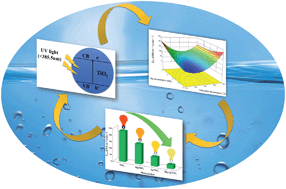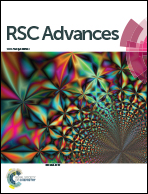Minimization of electrical energy consumption in the photocatalytic reduction of Cr(vi) by using immobilized Mg, Ag co-impregnated TiO2 nanoparticles†
Abstract
Magnesium and silver co-impregnated TiO2 nanoparticles were immobilized on a glass plate and used as a fixed-bed system for photocatalytic reduction of Cr(VI) to the less harmful Cr(III). Response surface methodology as a statistical technique was employed for optimizing the preparation conditions of Mg–Ag/TiO2, focusing on minimization of electrical energy consumption as the most important factor in selecting a wastewater treatment technology. Results showed that maximum photocatalytic reduction (84.44%), with minimum electrical energy consumption (30.31 kW h per m3 per order) were achieved at the optimized preparation conditions: Mg content of 0.82 wt%, Ag content of 2.6 wt%, and calcination temperature of 495 °C, whereas at the same conditions, using pure TiO2, Mg/TiO2, and Ag/TiO2 samples lead to 21.17%, 32.59%, and 63.61% photocatalytic reduction rates, and 232.1, 152.03, and 71.42 kW h per m3 per order electrical energy consumptions, respectively. The optimized Mg, Ag co-impregnated TiO2 nanoparticles were characterized by using XRD, SEM, TEM, DRS, EDX, and PL techniques. The considerable PL quenching in the co-impregnated TiO2 with optimized metals content suggests that the co-impregnation of Mg and Ag onto TiO2 could effectively inhibit the recombination probability of photogenerated electrons–holes pairs. Co-impregnation of Mg and Ag metals, and optimization of preparation conditions provides a synergistic effect in enhancement of the TiO2 activity and effective minimization of the electrical energy consumption and treatment cost.


 Please wait while we load your content...
Please wait while we load your content...